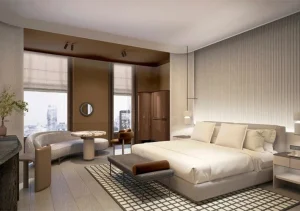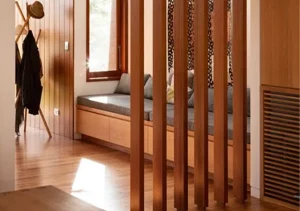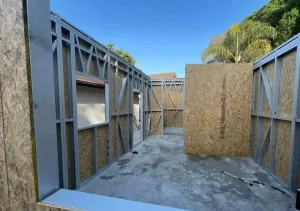Table of Contents
ToggleOverview: Why Now Matters
As we enter 2025, the demand structure for decorative materials continues to converge toward three dimensions: sustainability, fast installation, and acoustic aesthetics. Bamboo charcoal wood veneer (hereinafter referred to as bamboo charcoal veneer) is gaining traction as an interior wall solution that balances functionality and aesthetics. Thanks to its renewable raw material base, user-friendly installation system, versatile surface options, and compatibility with acoustic structures, it is rapidly moving beyond being just a cost-effective alternative material to becoming a mainstream choice in interior projects.
The supporting supply chain is also more mature: UV surface systems, expanded color and texture libraries (metallic, leather grain, stone grain, light wood tones), standardized sub-frames and connectors, and quick-mount accessories—all of which provide scalability for contractors and developers.
From a broader perspective, bamboo-based product categories are expected to grow steadily. Public research shows that the global bamboo market will reach approximately USD 79.3 billion in 2025, with a CAGR of 6.5%, driven by sustainable consumption and architectural applications. Similarly, the acoustic panel market is also growing steadily, reflecting the continued demand for both “beauty + sound absorption”—a trend that fits bamboo charcoal veneer perfectly.
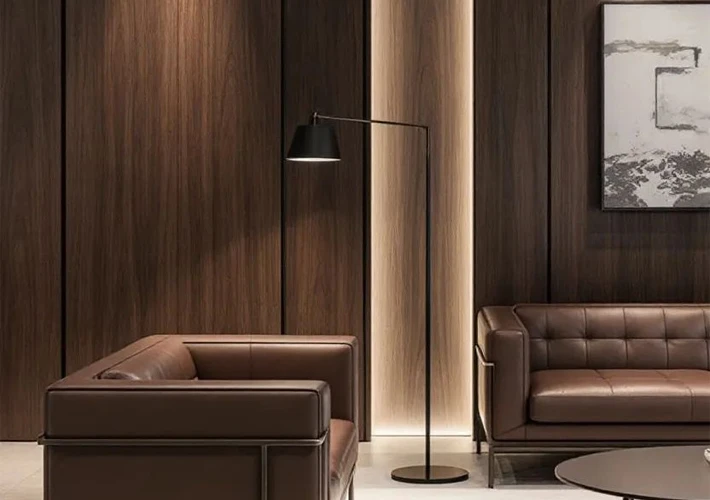
Five Key Demand-Side Trends
1) Sustainable Substitutes Enter Procurement Lists
Design guidelines in Europe, the U.S., and the Middle East increasingly emphasize life-cycle cost, maintainability, and sustainability in tender requirements. Compared with WPC, UV marble sheet, or natural veneer, bamboo charcoal veneer scores higher on the “sustainability + budget control + delivery speed” triangle. It is becoming the go-to option for hotels, commercial chains, and long-stay apartments. Moreover, the growth outlook for bamboo-based materials (such as bamboo plywood) provides psychological reassurance to design teams when specifying bamboo-based panels.
2) Acoustic Aesthetics as a Standard Feature
From offices and cafés to residential home theaters, acoustic performance remains a hot demand in 2025. Market reports forecast a 7% annual growth rate for acoustic panels in 2024–2025, while wood acoustic panels are expected to maintain ~6% CAGR through 2030. By combining bamboo charcoal veneer as the surface layer with acoustic substrates (PET felt, perforated board, or mineral wool), contractors can deliver both linear aesthetics and functional mid/high-frequency sound absorption.
3) Full-Wall and “Wrapped” Designs on the Rise
International residential and commercial projects are increasingly adopting panel-drenching (full-wall surface treatments) with consistent material and color tones. Bamboo charcoal veneer naturally adapts to this trend because of its flexible specifications and easy edge detailing.
4) Fast Installation and Maintainability in KPIs
Multinational hotel chains and retail stores focus heavily on minimizing downtime and construction disruption. With its dry-installation system, bamboo charcoal veneer enables fast installation, easy replacement, and reduced overall costs, making it highly scalable across multiple locations. Supplier listings highlight keywords such as “easy installation, fire-resistant, waterproof, flexible,” echoing these customer pain points.
5) Compliance as a Priority (Especially in North America)
Since March 2024, the U.S. TSCA Title VI regulation has enforced stricter compliance for laminated products. In 2025, North American clients are far more concerned about third-party certification, labeling, and traceability. For exporters and engineering suppliers, “TSCA Title VI / CARB P2 compliance” is no longer optional—it’s the entry ticket.
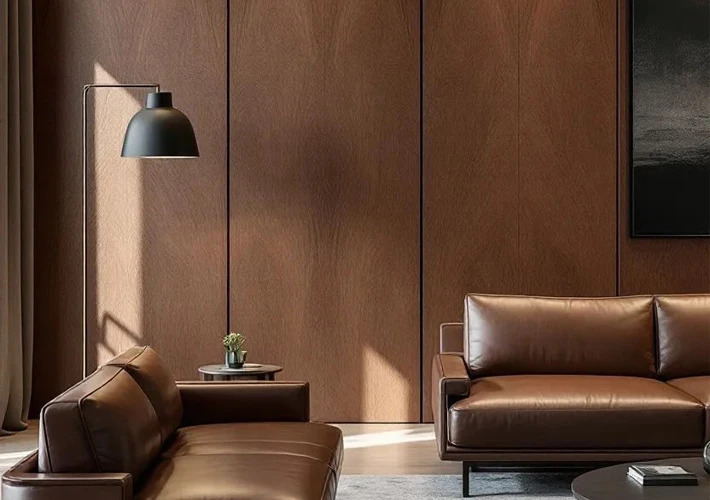
Seven Supply-Side Product Evolution Trends
1) Surface Systems: From Basic Film to UV Functional Coatings
Clients increasingly demand scratch resistance, stain resistance, anti-fingerprint, and easy cleaning. Bamboo charcoal veneer surface treatments are evolving from basic PVC/PET film to UV top-coating with multi-functional layers, offering enhanced gloss control and tactile variety. Factories are also expanding stock to include metallic finishes, leather textures, mineral stone looks, and soft matte wood grains.
2) Modular Acoustic Integration
Common structures include:
- Bamboo charcoal veneer + perforated board + acoustic substrate (PET/mineral wool)
- Linear slats with black acoustic felt backing
This hybrid approach delivers both aesthetic rhythm and effective RT60 control, with lower cost and faster delivery than natural wood veneer or stone.
3) Fire Resistance and Low Emission Standards
TSCA Title VI and CARB P2 enforce strict formaldehyde emission limits (e.g., MDF ≤ 0.11 ppm, particleboard ≤ 0.09 ppm, plywood ≤ 0.05 ppm). In 2025, export-ready bamboo charcoal veneer must use low-formaldehyde MDF/NAF/ULEF substrates with third-party TPC certification and full traceability.
4) Flexible Formats: Large Panels + Small Modular Sizes
Standard widths such as 1220mm remain mainstream for wall cladding, while 150/200/300mm modular slats are gaining traction for acoustic and decorative rhythm. Factories now emphasize customizable lengths, curved applications, and matching trim kits to reduce on-site cutting.
5) Metallic and Leather Elements as Design Enhancers
In 2025, fine metallic strips (gold, black titanium, brushed steel) and leather textures are widely used in commercial spaces. Bamboo charcoal veneer can easily replicate these finishes at lower costs.
6) Price Band Clarity for Project Procurement
Public supplier listings indicate that for projects of 500–1000 sqm, entry-level bamboo charcoal veneer can start around USD 3.4–3.6/m² (factory reference only, final CIF varies). This pricing makes it competitive for hotel renovations and retail chains.
7) From Panels to Complete Systems
Customers now expect one-stop supply: surface panels + sub-frames + clips + trims + installation manuals. Leading suppliers also provide BIM libraries, shop drawings, and SOPs, enabling overseas teams to replicate installations efficiently.
Regional Market Insights
North America (U.S. & Canada)
- Compliance-driven: TSCA Title VI strict enforcement since March 2024 requires laminated products to have certificates, batch labels, TPC test records, and import documentation.
- Applications: Office retrofits, healthcare, education, long-stay apartments, hotel renovations.
- Design Preferences: Light wood tones, warm gray stone textures, subtle metallic lines; acoustic slat + felt systems are very popular.
Europe
- Eco-priority: High sensitivity to recyclability, low VOC, and life-cycle data.
- Design Style: Light, muted colors, minimalist geometry; full-wall paneling and seamless trims common in both residential and commercial projects.
Middle East
- Aesthetic Preference: Metallic accents, stone textures, and leather finishes.
- Execution: High attention to detail in trims, requiring visualized installation manuals and site training.
Southeast Asia & Oceania
- Fast-track Renovations: Retail and office projects value replaceable, low-maintenance panels.
- Durability: Demand for scratch-resistant and stain-resistant UV finishes is strong, especially in F&B environments.
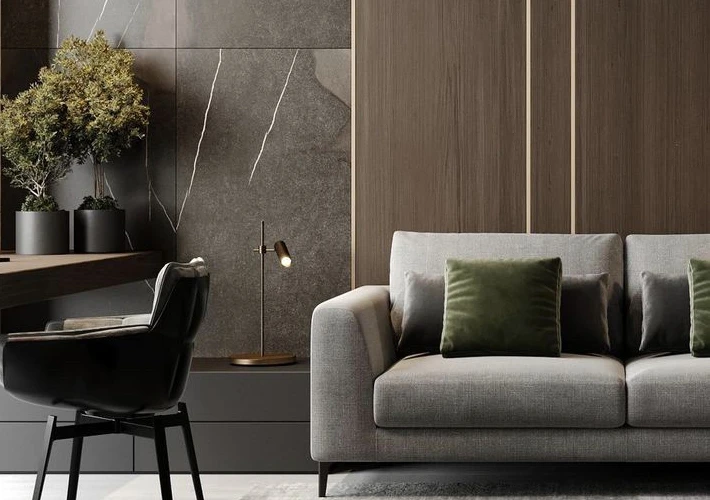
Competitive Positioning Against Other Materials
- Versus Natural Veneer: Bamboo charcoal veneer offers better pricing, shorter lead times, easier maintenance. With synchronized textures, micro-matte coatings, and metal inserts, it can achieve a “real wood look.”
- Versus Natural Stone: Stone is heavy, costly, and hard to maintain. Bamboo veneer offers lightweight stone-look panels with metallic trims at a fraction of the cost.
- Versus UV Marble Sheets: Bamboo veneer highlights warm tactile feel and acoustic adaptability, offering bundled acoustic systems as a differentiator.
- Versus WPC Panels: WPC dominates outdoor and waterproof areas, while bamboo veneer excels indoors with aesthetic, acoustic, and fine detailing advantages.
Practical Recommendations for Suppliers
(A) R&D & Compliance
Adopt low-formaldehyde MDF/NAF/ULEF substrates to meet TSCA Title VI/CARB P2 (MDF ≤ 0.11 ppm, PB ≤ 0.09 ppm, plywood ≤ 0.05 ppm).
Ensure laminated products follow March 2024 requirements, with correct labeling, testing, and import documentation.
Prepare fire-resistant and VOC reports for hospitality, healthcare, and education projects.
(B) Product Portfolio
Standard series: 1220mm flat boards and modular 150/200/300mm slats; maintain a 20–40 SKU core color range.
Functional series:
- Acoustic slat systems (veneer + felt + sub-frame)
- Micro-perforated or grooved panels with acoustic backing
- UV anti-scratch and anti-fingerprint finishes
Pricing strategy: Offer 500–1000 sqm entry-tier pricing to penetrate pilot projects and retail chains.
(C) Delivery & Service
Provide full system packages (panels + sub-frame + trims + SOP + shop drawings).
Supply BIM libraries and installation animations.
Offer multi-language manuals (EN/ES/FR/AR) for overseas teams.
Prepare sample kits: color swatches + three style mock-ups (minimalist, luxury, natural) + acoustic demo samples.
Application Scenarios
1) Hospitality
- Pain Point: Downtime and durability.
- Solution: Slat systems or large panels with seamless trims; fast dry installation; UV finish reduces cleaning costs.
- Value Add: Acoustic performance for corridors and lobbies.
2) Offices & Education
- Pain Point: Acoustic comfort and flexible retrofits.
- Solution: Perforated veneer panels + PET felt backing; modular slats for easy upgrades.
3) Retail & F&B
- Pain Point: High traffic, easy maintenance, brand consistency.
- Solution: UV high-durability finishes with metallic or leather accents; modular formats for quick store rollouts.
4) Residential & Apartments
- Pain Point: Cost and indoor air quality.
- Solution: Full-wall veneer systems with low-VOC substrates, fast installation, and replaceable sections.
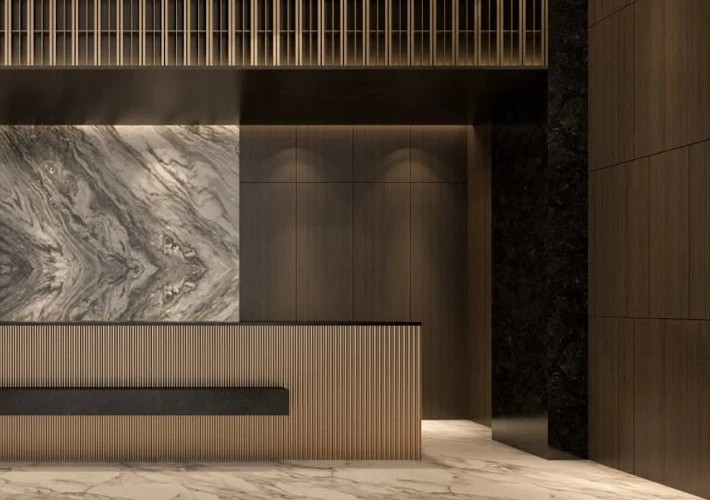
Branding & Marketing Positioning
Key Messaging:
- Sustainability (renewable bamboo, lightweight transport, replaceable panels)
- Fast Installation (dry system, modular trims, short lead times)
- Acoustic Aesthetics (slat and perforated acoustic modules)
- Compliance Transparency (TSCA Title VI/CARB P2 certificates, traceability, import compliance)
Content Assets: Case photos, detail drawings, installation videos, BIM files, texture swatches.
Decision-Making Tools: Provide cost breakdowns, life-cycle cost comparisons, and compliance document packs.
Design Trend Marketing: Highlight “panel-drenching” trend reports to position veneer as a modern, whole-wall solution.
Risks & Countermeasures
- Compliance Risk: TSCA Title VI enforcement and laminated product labeling requirements.
→ Solution: Work with EPA-recognized TPCs, maintain batch records and documentation, and deliver full compliance packages. - Style Homogenization: Over-reliance on light wood + metallic strips.
→ Solution: Expand leather, fabric, stone, and micro-matte finishes with lighting integration. - Price Competition: Market undercutting risks.
→ Solution: Position as a system provider (panels + trims + acoustic solutions + compliance) rather than just a “board seller.”
2025 Action Checklist for Chinese Manufacturers
- Build three core lines: standard wall panels, modular acoustic slat systems, and perforated acoustic panels.
- Establish TSCA Title VI/CARB P2 compliance packs (TPC certs, batch labels, test records, import guidance).
- Provide multi-language SOPs and installation guides.
- Create marketing around sustainability, speed, acoustic design, and compliance transparency.
- Develop three-tier pricing strategy: pilot project price, chain roll-out price, annual framework price.
Conclusion: A Direct Note to Buyers
We are a China-based manufacturer of bamboo charcoal veneer panels, supplying surface boards, sub-frames, connectors, trims, installation SOPs, and compliance documentation.
If you are planning hotel, office, retail, or residential projects, we can deliver samples and detail drawings within 7–10 working days, along with TSCA Title VI/CARB P2 certified materials and third-party reports for North American and global projects.
Send us your drawings, BOQ, or project details, and we will prepare 1–2 tailored solution options with complete material lists, helping you strike the optimal balance between budget, lead time, and compliance.


